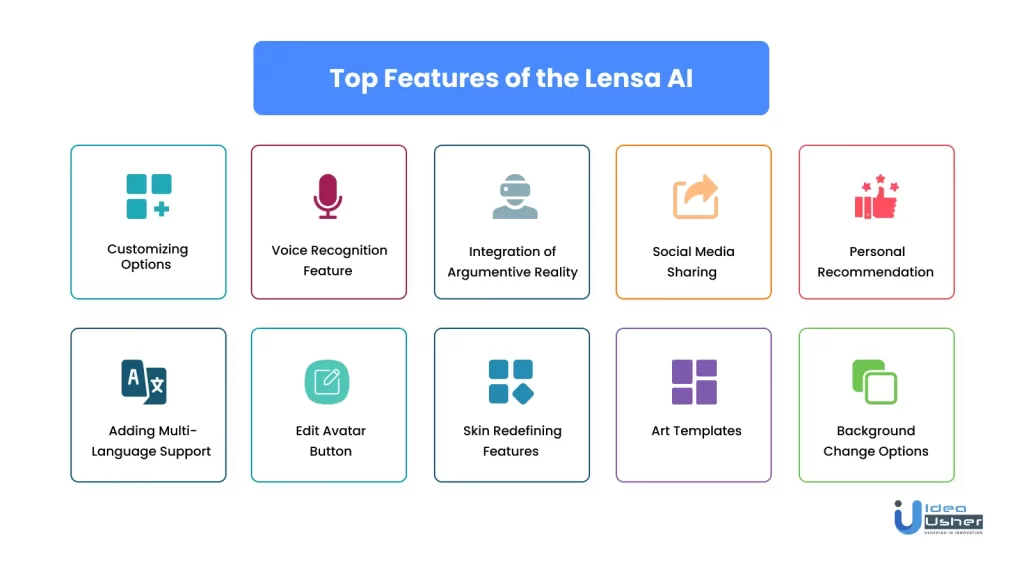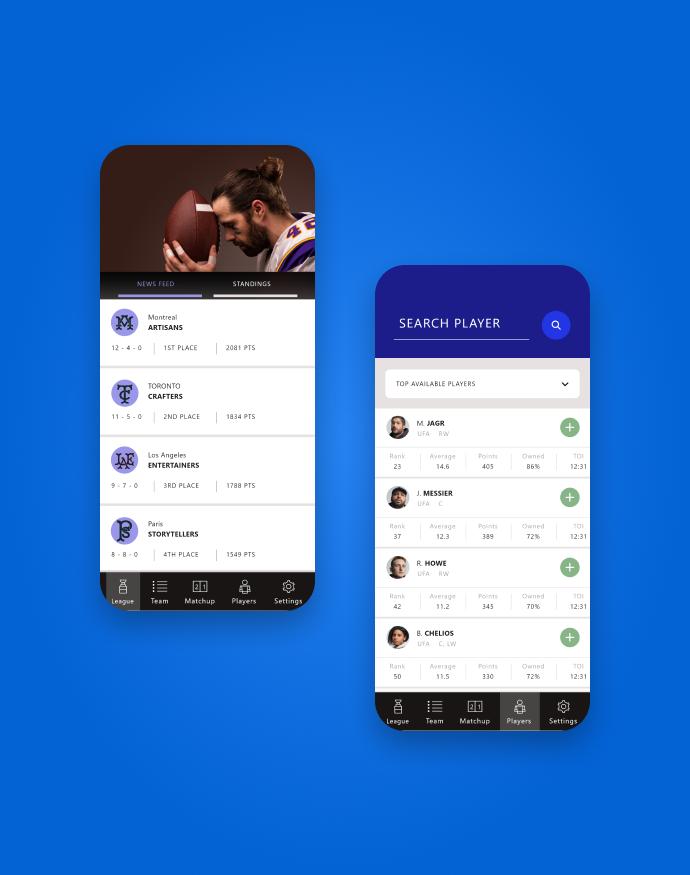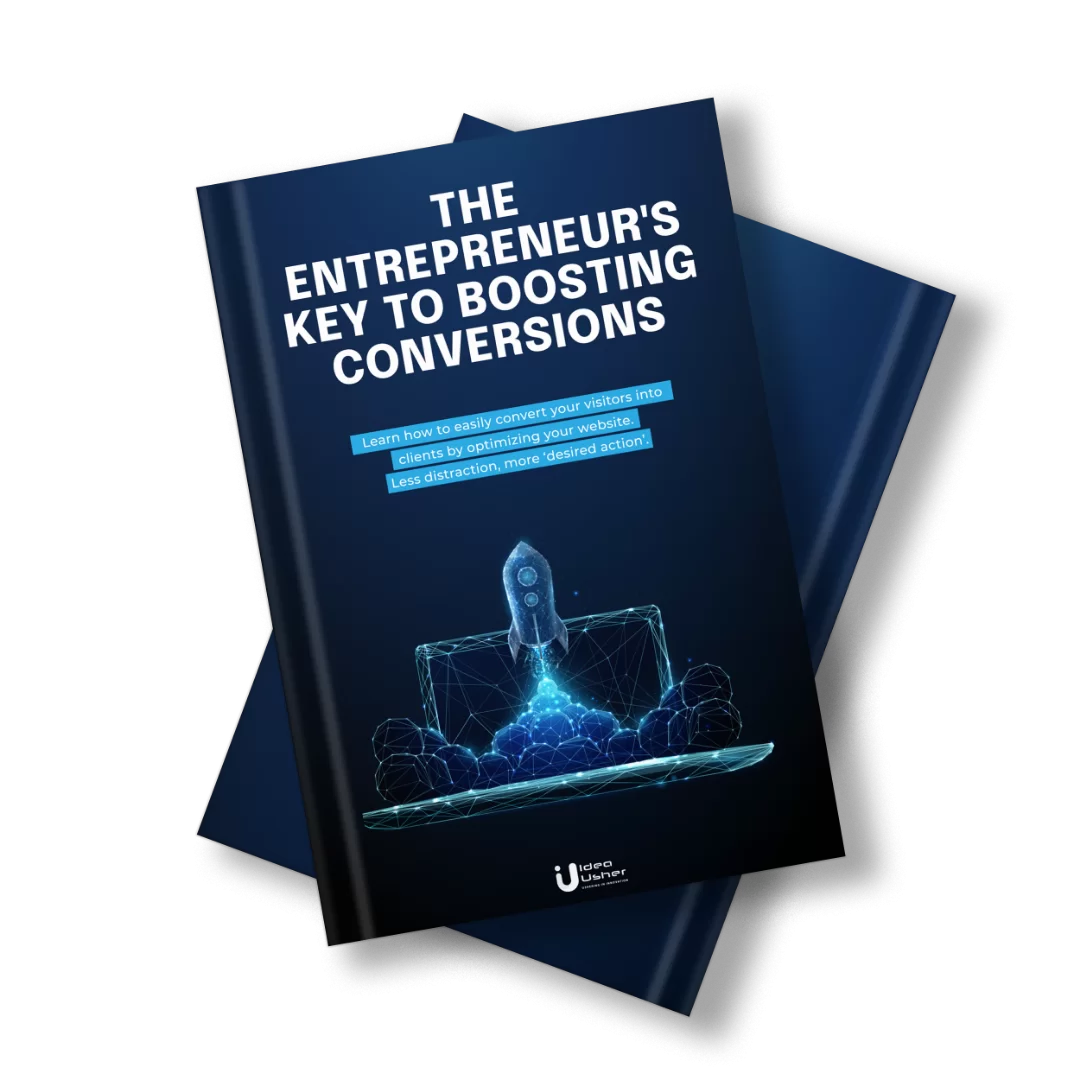- What Exactly is Lensa AI
- Market statistics for Lensa AI Art Generator:
- Top Features of the Lensa AI
- Top 5 Alternatives of the Lensa App
- Building an AI Avatar App: The Essential Steps
- Required Tech Stack for Building an App Like Lensa AI
- How AI Apps Like Lensa Create Artistic Avatars
- Build an AI Art App Like Lensa with Idea Usher
- Conclusion
- FAQ’s
Without a doubt, artificial intelligence has completely taken over our day-to-day tasks, from generating content to artificial intelligence getting integrated into software and companies’ management systems to help them ease the work. The possibilities of working with artificial intelligence are endless has no stop.
But the AI is not only restricted to the above artificial intelligence; we can create and generate avatars; avatars are lookalikes of us in a computer-generated form that can be used in different ways like chatting, playing games, and even attending meetings using our computer-generated lookalikes, but how can AI play an essential role in this?
With the integration of AI, the user can take a selfie of themselves, scan their face from different angles, and integrate that into an avatar which is an exact representation of them; apps like Lensa AI are the resin we can do so.
AI and avatars are two types of technologies combined to open up new possibilities. Avatars are computer images of people or characters that can interact with users in a virtual world. Avatars can grow more intelligent and more human-like by using AI, making them even more entertaining.
Apps like Lensa AI have gained so much popularity that they have generated revenue of 16.2 million dollars in the year 2022, a download of over 25 million.
You must be wondering about this unique technology that integrates AI and avatars and if you can build an app like this.
So here is a complete guide to help you with the app-building
Let us start without any further ado.
- What Exactly is Lensa AI
- Market statistics for Lensa AI Art Generator:
- Top Features of the Lensa AI
- Top 5 Alternatives of the Lensa App
- Building an AI Avatar App: The Essential Steps
- Required Tech Stack for Building an App Like Lensa AI
- How AI Apps Like Lensa Create Artistic Avatars
- Build an AI Art App Like Lensa with Idea Usher
- Conclusion
- FAQ’s
What Exactly is Lensa AI
Lensa App is a mobile application designed to enhance and beautify photos using advanced AI-powered technology. The app is available on both iOS and Android platforms and has gained widespread popularity among users due to its ease of use and high-quality results. The app allows users to create avatars that look like themselves or any other person, using just a photo as a reference. The avatars created by the app are highly detailed and realistic, with lifelike features and expressions.
The app was developed by the Ukrainian company Prisma Labs and was launched in 2021. Since then, the app has seen significant growth in the number of downloads as well as the number of users; let us understand the working and the growth of the Lensa app below.
How Lensa AI Works?
Here is the step-by-step functioning on how the app works and lets you create an avatar from your images
- The user starts by uploading a photo of themselves or someone else to use as a reference for the avatar.
- The app uses computer vision technology to analyze the features of the face in the photo and reads the facial features.
- Machine learning algorithms are then applied to create a highly detailed and realistic avatar based on the facial features in the photo.
- The app uses a variety of techniques to create a lifelike representation of the user, including skin tone, eye color, hairstyle, and facial expressions.
- The app allows users to customize their avatars by changing features such as hair, eye color, and clothing; this feature is an essential part of creating the avatar.
- The avatar can be saved as an image or a video and can be shared on social media platforms such as Instagram and Facebook.
- The app also offers a feature called “Avatar Chat,” which allows users to chat with others using their avatars in real time and send reactions and messages.
Growth Trend of the Application
Without a doubt, the app has seen a major growth trend in recent years; here are the few reasons below that lead to significant growth of the app. The app has been significantly growing since its launch, and the app has seen a jump in users; let us explore the active user base of the Lensa app.
The app has an active user base of more than 1 million users at present and many more counting.
The Lensa AI Avatar App has a diversified and widespread user base comprising people of various ages, genders, and cultures. The software has grown in popularity among people who want to learn more about the capabilities of AI technology and create personalized avatars.
Social media influencers, celebrities, and content creators are among those who use the program to build avatars for their online personas. These users take advantage of the app’s advanced technology to create highly realistic and visually appealing avatars, allowing them to stand out in a crowded online space.
Advanced AI Technology Integration
The app’s excellent technology is an important element in its popularity. The program creates very realistic avatars that mirror the user’s facial characteristics using cutting-edge machine-learning algorithms and computer vision technologies. This technology is both creative and amazing, and it has captured the interest of many users who want to learn more about AI’s possibilities.
User-Friendly Interface
Because of the app’s user-friendly interface, it is accessible to a wide variety of users. The app is simple to use and offers plenty of customization choices for users to personalize their avatars. The app’s user-friendly UI has helped it attract a wide user base.
Social Media Integration
The app’s strong social media presence has also helped it grow. The company widely promoted user-generated content on sites such as Instagram and TikTok, which increased the app’s visibility and attraction. This social media promotion has additionally assisted in the formation of a community of users who share their avatars and interact with one another online.
Viral Marketing Trends
The app’s unique features and capabilities have made it an increasingly common topic of discussion on social media. Many users have shared their avatars on various platforms, creating a lot of buzz and increasing the app’s visibility. This viral marketing helped in the app’s growth by attracting new users.
Market statistics for Lensa AI Art Generator:
Downloads:
- December 2022: 19.3 million (global)
- January 2023: 1.4 million (global)
Revenue:
- 2022: $16.2 million
- December 2022: $8 million (peak month)
- Estimated monthly revenue (Jan 2023): $656,000 (based on downloads)
Monetization:
- Freemium model with a free trial
- In-app purchases for avatar generation (priced per set)
Market
- Global Free AI Art Generator Market Size (2023): $299.3 million
- Global Free AI Art Generator Market Size (CAGR 2023-2030): 17.4%
Top Features of the Lensa AI

Before understanding the building process, we need to look at the features that Lensa AI provides to its users that make them stand out from the rest of the AI avatar generative tools.
Customizing Options
The ability to customize your avatar so it looks like you is an essential function of any AI avatar program. Users should be able to customize their avatars by selecting their gender, skin tone, facial features, and other physical characteristics. The more customizable options a user gets, the more interactive the app is, like adding a new variety of clothes and hairstyles for avatar customization.
Voice Recognition Feature
Another advanced feature that allows users to connect with their avatars using spoken language is voice recognition. Lensa AI, for example, should be able to recognize and respond to voice commands, making it easier for users to interact with their avatar. Adding such premium features so that the user can interact with the avatar makes the app stand out from other market competitors.
Integration of Argumentive Reality (AR)
AR is a technology that overlays digital components in the virtual environment. Your AI avatar app can use augmented reality (AR) technology to provide users with additional immersion, allowing them to see their avatar in real-world settings and interact with it in new and exciting ways.
Social Media Sharing
Integrating your AI avatar app with popular social media sites like Facebook, Instagram, and TikTok can help it gain traction and reach. Users can share their avatars with their friends and followers on social media, increasing the visibility of your app and encouraging user engagement. Moreover, the user can use these avatars in chatting and while interacting on online platforms.
Personal Recommendation
Machine learning algorithms can be used in your customized app to create personalized user recommendations based on their preferences and usage history. If users frequently use their avatars to produce video material, your app can provide additional editing tools or AR filters to enhance their results. Adding a mix of personal recommendations makes the user feel more connected to the app and thus helps to increase app interaction and downloads.
Adding Multi-Language Support
Multi-language support is essential for making your AI avatar app more accessible to a broader audience. Your software should be able to recognize and respond to commands in several languages, allowing users to communicate with their avatars regardless of their ability to speak. Adding multi-language support potentially increases the number of downloads because of the reach across different regions and breaking the cultural barriers.
Edit Avatar Button
Your AI art generator app must allow users to customize their avatars. As a result, you must include features such as an eye enhancer, red eye corrector, brightness and contrast settings, grayscale, highlights, and shadows, among others. Moreover, adding the edit button saves the user from creating a new avatar or deleting the new one if they wish to change their avatar.
Skin Redefining Features
In addition to image editing, magic correction or skin refining effects are popular. As a result, in your AI avatar app like Lensa AI, you must likewise provide these features to your users. Users should be able to utilize the tools to hide defects, focus on specific body regions, make each portrait selfie crisper, and apply any other cosmetic effects they choose to their photos.
Art Templates
Instagram and Snapchat are popular due to the entertaining filters and templates they provide to users. As a result, you should include it in your AI art generator software. To keep users engaged, you can provide them with various pre-built templates with backgrounds and other components and release new filters regularly.
Background Change Options
Like other popular photo editing apps, you must allow users to change the image background with a tap. The users must be able to select from various online locations to enhance their digital art and selfies. The user should also be able to add their background photo if they wish to; thus, a feature to import background should be provided.
The possibilities of customization, voice recognition, AR integration, social media sharing, personal recommendations, multi-language support, editing options, skin refining features, art templates, and background change options are some of the exciting features that can make AI avatar apps stand out in the market and offer engaging experiences to users.
Top 5 Alternatives of the Lensa App
Lensa app is one the most popular apps for creating AI-generated avatars using one’s pictures; here are the top 5 alternatives for the Lensa app; let us explore those.
Zmoji
Zmoji is a well-known avatar-maker program that allows users to build extremely customizable avatars. The program provides numerous customization possibilities, such as new clothing, accessories, and hairstyles. Zmoji also has a function called “Zmoji Camera,” which allows users to utilize their avatars to take images and videos.
Bitmoji
Another popular avatar generator tool is Bitmoji, which allows users to create unique cartoon avatars. The program provides numerous personalization choices, such as new clothing, haircuts, and accessories. Bitmoji also designs with popular social media sites like Snapchat, allowing users to use their avatars in a variety of situations.
Animoji
Animoji is an Apple avatar creator app that allows users to create animated avatars. The program animates the user’s facial expressions using face recognition technology, allowing users to create a highly realistic image of themselves. Animoji allows for a wide range of customization possibilities, including various animals and characters.
Bobble Keyboard
Bobble Keyboard is an avatar-maker tool that allows users to design their own stickers and emoticons. The program creates avatars based on the user’s facial features using machine learning technology, allowing them to construct a highly realistic image of themselves. Bobble Keyboard provides numerous customization choices, such as different hairstyles, accessories, and clothes.
SuperMii
SuperMii is an avatar creator program that allows users to design their own cartoon avatars. The software provides numerous customization possibilities, such as different facial characteristics, haircuts, and clothes. SuperMii also has a function called “Comic Strip,” which allows users to make their own comic strips with their avatars.
Building an AI Avatar App: The Essential Steps
Here are the important steps that you need to consider while building an AI avatar app; let us discuss the below in complete detail.
Step #1:Defining the Project Scope/Aim.
If you want to create an app that generates digital art using AI, the first thing you need to do is figure out what kind of art you want to make. You should think about things like the style, colors, and overall look of the art. It’s also important to set goals for your app, like who your target audience is, what features you want to include, and how you plan to market and make money from it.
To create a great app, you need to do some research and find out what your competitors are doing. This will help you make sure your app stands out from the rest. You also need to make sure you have the resources you need to create your app and track your progress along the way.
Overall, creating an AI art generator app can be a fun and exciting project. Just remember to start with a clear idea of what you want to achieve, set goals, and do your research to make sure your app is a success.
Keeping the following questions in your mind can give the required headstart to the app-building process.
- Who should my target market be?
- What capabilities, technologies, and tools should I include in my AI avatar app?
- How can I promote my app?
- Which elements will I require to construct an AI art generation app?
- How can I make money from my app?
- How can I monitor the success of my marketing campaigns?
Step #2: Hiring the Required Mobile App Developers
This is an essential step since recruiting a good set of developers can lead to the required success of your application; overall, having a team of developers that is inefficient can be a complete waste of all resources and time.
Look for developers who have already created similar apps and can show a portfolio of their work. Furthermore, consider their level of communication and collaboration, as you’ll need to work closely with your developers to ensure the app meets your expectations.
When looking for developers, make sure to talk about the features and functionality you want in your app, such as customizable avatars, voice recognition, and AR integration. Remember to talk about timeframes, budgets, and ongoing maintenance and support.
You can create an AI-based mobile app like Lensa AI that stands out from the crowd and delights your consumers by selecting the proper team of mobile app developers.
Step #3: Build a Minimum Viable Product (MVP)
Creating an app may be a challenging and expensive process, and there is always the risk of creating something that fails to connect with people. This is where an MVP can help. You may test your app idea in the market and obtain feedback from real users by establishing a minimum viable product before investing in complete development. This not only saves you money but also decreases the danger of creating a product that no one wants to use.
Here are some factors considering the MVP
- A minimum viable product (MVP) is a low-cost technique to test your app concept in the market and gain useful feedback from users before investing big sums of money in full-scale development.
- It allows you to identify the essential features that your app should have in order to suit the demands and preferences of your consumers.
- With an MVP, you can gradually develop and enhance your product, adding new features and functionalities in response to user input and market demand.
- Before releasing the full-scale app, deploy an MVP to grow a user base and establish a brand identity. This can assist you in attracting investors and securing funds for future development.
- It also helps you decrease the time it takes for your software to reach the market, giving you a competitive advantage over competitors.
- Finally, an MVP can be a useful marketing tool because it can be shown to potential investors, partners, or customers, resulting in early traction and interest in your product.
Step #4: Choosing the Correct AI Model
Once the MVP is complete, you must begin your work by developing an AI avatar app like Lensa AI. However, before you begin the development phase, you must select an appropriate model to serve as the basis for your AI selfie generator similar to that of the AI face swap app replica.
Below are some of the models; let us discuss them all in detail.
Variational Autoencoder (VAE)
VAEs are generative models that learn a compressed representation of input images from which new images can be generated. They are frequently utilized in picture editing apps for image production and style transfer.
Generative Adversarial Networks (GANs)
GANs generate realistic images by simultaneously training two neural networks, one to generate images and the other to evaluate the generated images. They are frequently employed in picture editing, style transfer, and image synthesis.
Auto-Regressive Models
These models are taught to generate pixel sequences based on a particular input image. They are often utilized in picture editing apps for image colorization and inpainting.
Style Transfer Models
These models transmit the style of one image to another. They’re frequently employed in photo editing programs to add artistic flair to photos.
Step #5: Collect the Data and Prepare the Model
Now let’s dive into the technical details of AI avatar app development. After finalizing the designs, the next step is to work with datasets, create AI models, train them, and test them in different conditions. Here’s how it works:
- You’ll need a large dataset of digital images that represent the style and type of art you want to generate for your AI avatar app. You can either create your dataset or use existing datasets available online.
- Preprocessing is the next step, which involves cleaning the data, resizing the images, and normalizing the pixel values to make it suitable for training the AI model.
- To train the AI model, you can use convolutional neural networks (CNNs). These networks learn to recognize image patterns and generate new artwork based on the input.
- Once the AI model is trained, you need to test it to ensure it can generate high-quality digital art. You can do this by inputting a sample image and evaluating the output. If the output isn’t satisfactory, you may need to fine-tune the model or adjust the training parameters.
Step #6: Develop an AI Application
Now comes the technical aspects related to AI avatar app development. Once the designs are finalized, the next big step is to play with the datasets, create AI models, train them, and test them under different conditions.
To create an AI avatar app like Lensa AI, you will need a large dataset of digital images representing the style and type of art you want to generate. You can either create your dataset or use existing datasets available online.
Once you have collected the data, you need to preprocess it to make it suitable for training the AI model. Preprocessing involves cleaning the data, resizing the images, and normalizing the pixel values.
You can train the AI model using convolutional neural networks (CNNs). The CNNs will learn to recognize image patterns and generate new artwork based on the input.
Once you have trained the AI model, you need to test it to ensure it can generate high-quality digital art. You can test the model by inputting a sample image and evaluating the output. If the output is unsatisfactory, you may need to fine-tune the model or adjust the training parameters.
Step #7: Testing and App Deployment
Testing your AI avatar app is a critical stage of the development process. It helps you identify any bugs or performance issues before deploying your app in the market. Here are some additional points to consider:
- Testing ensures that your app meets the expected quality standards and user experience.
- It helps you verify if the app functions as expected and meets the defined requirements.
- Testing helps identify and eliminate performance bottlenecks, such as slow response times or memory leaks.
- With testing, you can ensure that your app is secure, free of vulnerabilities, and meets regulatory compliance requirements.
- Testing your app with real-world scenarios and data can help you gain insight into user behavior and preferences, which can be used to improve the app in future releases.
- Once your app has passed testing, you can deploy it to the market confidently, knowing that it meets the quality standards and user expectations.
Overall, testing is a crucial stage in the development process and should not be overlooked or underestimated. It helps you ensure the success of your AI avatar app by delivering a high-quality, reliable, and user-friendly product.
Required Tech Stack for Building an App Like Lensa AI
Node.js:
JavaScript runtime that allows running JavaScript code on the server side.
Javascript:
The programming language used to create interactive web pages and web applications.
HTML
A markup language used to create web pages and applications.
CSS
A stylesheet language used to add styles and formatting to web pages and applications.
AWS
A cloud computing platform provides various services, such as computing, storage, and databases.
Stable diffusion
A technique used in AI that allows training models to generate consistent and stable outputs.
Google Colab
An online platform for coding, running, and sharing machine learning models.
DreamBooth
An app that uses AI to generate digital art.
Google Drive
A cloud-based storage service allows users to store and access files and documents from anywhere.
Hugging Face
A company that provides various natural language processing (NLP) tools and models.
GAN (Generative Adversarial Networks)
A type of machine learning model used for generating synthetic data.
VQGAN+CLIP
A combination of two machine learning models is used for generating high-quality images.
How AI Apps Like Lensa Create Artistic Avatars
Have you ever wondered how apps like Lensa AI take a selfie and transform it into a fantastical work of art? The process is actually quite fascinating and utilizes the power of artificial intelligence. Let’s delve into the magic behind Lensa’s AI art generation.
- The journey begins with you providing the app with a source image, typically a selfie. This image serves as the foundation for your artistic transformation. Lensa then employs computer vision technology, a type of AI that can analyze and understand visual data. This technology meticulously examines your selfie, identifying key facial features like your eyes, nose, and mouth.
- Once the facial features are mapped, powerful machine-learning algorithms come into play. These algorithms have been trained on massive datasets of images, allowing them to recognize patterns and recreate them in unique ways. In Lensa’s case, the algorithms use their knowledge to generate an extraordinarily detailed and stylized version of your face, often incorporating artistic elements like specific painting styles or fantasy themes.
- The result is a captivating image that goes beyond a simple replica. It’s a creative interpretation that captures the essence of your features while infusing them with artistic flair. Lensa’s AI doesn’t stop at just faces; it can also incorporate details like hairstyles and expressions, further personalizing your artistic transformation.
- And the best part? You have some control over the final product. Lensa often allows users to tweak certain aspects of the generated art, such as hair color or style. This lets you add your own touch and create an avatar that truly reflects your personal taste.
- Finally, once you’re happy with your artistic masterpiece, Lensa lets you save it as an image or video, ready to be shared with friends and family on social media platforms or used as a unique profile picture. So, the next time you use Lensa, remember the fascinating AI technology working behind the scenes to turn your photos into art!
Build an AI Art App Like Lensa with Idea Usher
Idea Usher is a team of passionate developers specializing in crafting cutting-edge mobile applications, with a focus on AI integration. We excel at building user-friendly interfaces that make complex AI technology accessible to everyone.
Your AI art app, like Lensa, can empower users to transform selfies into unique artistic creations, exploring various styles and themes. It can be a platform for expressing individuality through a personalized avatar experience, sparking creativity and self-discovery.
Our team goes beyond just the artistic flair. We ensure your app is technically sound, and built with the latest AI technologies and development best practices. We prioritize a user-centric approach, designing intuitive interfaces for a seamless user experience. Security and compliance are also paramount, so your app will be built with robust security measures and adhere to industry regulations.
Idea Usher is here to collaborate with you every step of the way. We offer expert consultations to discuss your app concept and provide valuable insights from our AI specialists. We can handle custom development, and crafting an app specifically tailored to your unique vision and target audience. Our agile development process allows for collaborative work, ensuring your app meets your specific needs and timeline.
Don’t just dream of your AI art app, build it with Idea Usher. Contact us today for a free consultation and let’s turn your creative spark into a reality!
Conclusion
Creating an app like Lensa AI requires a combination of technical expertise, creativity, and attention to detail. You need to start by understanding the market, identifying your target audience, and defining the features and functionalities that your app should have. Once you have a clear idea of what you want to achieve, you need to focus on the design, user experience, and technical implementation.
Designing an AI avatar app involves creating stunning graphics, developing engaging interfaces, and defining the user flow. You need to pay attention to the smallest details, such as color schemes, fonts, and animations, to create a visually appealing and intuitive app.
Technical implementation involves setting up the infrastructure, choosing the right tools and technologies, and developing the AI models. You need to have a deep understanding of AI, machine learning, and computer vision, as well as expertise in software development, testing, and deployment.
If you’re planning to create an app like Lensa AI, it’s essential to work with an experienced and reliable app development company. Idea Usher is one such company that has a team of expert developers, cutting-edge technology, and a proven development methodology to bring your app to life.
So, if you’re looking forward to building your own application like Lensa, then contact Idea Usher today. With our expertise and commitment to quality, we can help you create a stunning AI avatar app that meets your business goals and delights your users.
FAQ’s
Q. What programming languages and tools are required for developing an AI avatar app like Lensa AI?
A. To develop an AI avatar app, you will need to have knowledge of programming languages like Python and frameworks like TensorFlow or PyTorch. You will also need access to cloud platforms for training and hosting your AI models.
Q. How much does it cost to develop an AI avatar app like Lensa AI?
A. The cost of developing an AI avatar app like Lensa AI can vary depending on the complexity of the app, the features you want to include, and the development team you choose. However, it can range from tens of thousands to hundreds of thousands of dollars.
Q. How long does it take to develop an AI avatar app like Lensa AI?
A. The development timeline for an AI avatar app like Lensa AI can vary depending on the complexity of the app and the resources you have available. However, it can take several months to a year or more to complete the development process.
Q. Can I use pre-existing AI models for my AI avatar app?
A. Yes, you can use pre-existing AI models for your AI avatar app. However, you may need to customize the models to meet your specific requirements and data.
Q. What are the key features that an AI avatar app should have?
A. An AI avatar app should have features like image recognition, style transfer, and AI-generated art. It should also have a user-friendly interface, image editing tools, and the ability to share the generated artwork on social media.













Rachit Gilhotra